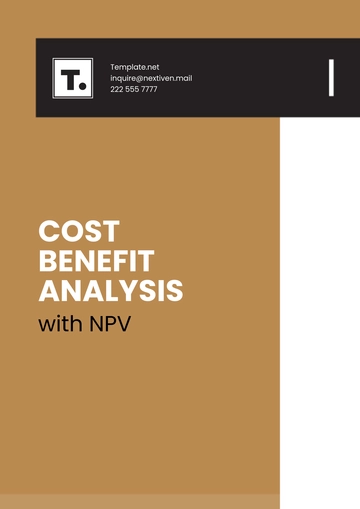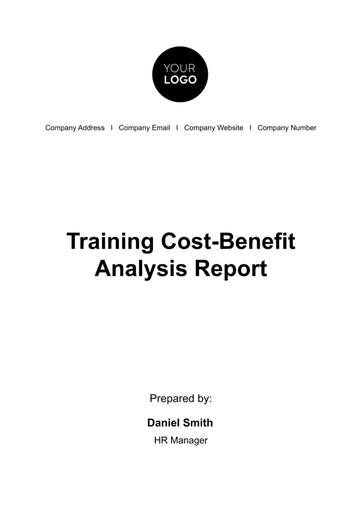Free Agriculture Environmental Financial Analysis

I. Introduction
Agriculture is not only a cornerstone of food production but also a significant contributor to environmental impacts such as resource depletion and greenhouse gas emissions. The imperative to adopt sustainable agricultural practices has never been more pressing, driven by global trends towards environmental stewardship and regulatory requirements. This analysis aims to quantify the financial implications of integrating sustainable practices at [Your Company Name], providing insights into how environmental considerations can be aligned with economic objectives to ensure long-term viability and resilience in the agricultural sector.
II. Methodology
A. Data Collection Methods
Sources of Financial Data
Financial data will be obtained from the extensive records maintained by [Your Company Name], which include thorough and detailed reports on various aspects of the company's financial activities. These records cover operational costs, capital investments, and revenue streams in great detail. The information derived from these comprehensive financial documents will not only highlight current financial conditions but will also use historical financial performance data as a benchmark. This historical data serves as a baseline against which to measure and evaluate the financial impacts of implementing sustainable practices within the company.
Sources of Environmental Data
The environmental data set will comprise thorough assessments derived from the environmental management systems employed by [Your Company Name]. These assessments will meticulously document various metrics, including the usage and consumption of water resources, indicators of soil health, and evaluations of biodiversity within the ecosystem. By adopting this holistic approach, [Your Company Name] aims to ensure that environmental impacts are measured in conjunction with financial metrics. This integrated method will facilitate a comprehensive analysis of all sustainability efforts, providing a well-rounded understanding of the organization's environmental performance in tandem with its economic outcomes.
B. Analysis Techniques
Cost-Benefit Analysis
By making use of cost-benefit analysis, it will become possible to compare the initial expenses associated with implementing sustainable practices with the possible long-term savings and benefits that such practices might yield. This analytical approach will serve to quantify, in economic terms, the feasibility of making investments in sustainability, thereby providing a clearer picture of whether the potential financial returns justify the initial outlay.
Return on Investment (ROI) Calculations
Return on Investment (ROI) calculations will thoroughly assess the financial returns produced by sustainable investments. These calculations will specifically look at improvements such as enhanced efficiency in the use of resources and expanded market access. By conducting a detailed evaluation of both the financial gains and the environmental benefits stemming from these investments, [Your Company Name] can strategically prioritize those investments that are most in line with its overarching sustainability objectives.
Sensitivity Analysis
Sensitivity analysis will be used as a strategic tool to comprehend how fluctuations in commodity prices, alterations in regulatory frameworks, and changing climate conditions might influence the financial results of implementing sustainable practices. By adopting this forward-thinking methodology, [Your Company Name] aims to foresee and manage potential risks that may arise from environmental and economic uncertainties, thus ensuring a more resilient and sustainable business model.
III. Financial Analysis
A. Operational Costs
Cost of Inputs
[Your Company Name] bears considerable financial burdens associated with the procurement of agricultural inputs, which include but are not limited to seeds, fertilizers, and pesticides. These essential materials are integral to the farming processes and operations undertaken by the company. Over the duration of the past three years, the company's annual expenditures on these inputs have averaged an impressive $[00]. This figure is indicative of not only the scale at which [Your Company Name] operates but also the intensity and commitment required to maintain such extensive farming activities.
Year | Seeds ($) | Fertilizers ($) | Pesticides ($) | Total Input Costs ($) |
|---|---|---|---|---|
[Year] | [00] | [00] | [00] | [00] |
Labor Costs
Labor represents a substantial portion of the operational expenses incurred by [Your Company Name]. This includes the salaries and wages paid to farm workers who are responsible for a variety of critical tasks such as planting crops, harvesting produce, and carrying out general maintenance activities on the farm. Over the course of a year, the financial outlay for labor-related costs has averaged $[00]. This figure takes into account the fluctuations that naturally occur due to seasonal changes, as well as the different strategies implemented to manage the workforce efficiently throughout the year.
Year | Labor Costs ($) |
|---|---|
[Year] | [00] |
B. Capital Expenditures
Infrastructure Investments
In recent times, significant financial resources amounting to $[00] have been invested in the development and improvement of irrigation infrastructure. This initiative is specifically designed to enhance the efficiency of water usage and to minimize reliance on external water sources. Through the implementation of these advanced irrigation systems and the modernization of existing ones, it is anticipated that there will be substantial long-term savings. These savings are expected both in terms of reduced water consumption, due to the more efficient use of this vital resource, and in lower operational costs, owing to the decreased need for additional water supply and associated expenditure.
Year | Infrastructure Investments ($) |
|---|---|
[Year] | [00] |
Technology Investments
[The Complete Name of Your Company] has made significant investments in the realm of precision agriculture technologies over the past three years. These investments encompass advanced soil sensors and automated irrigation systems, amounting to a total financial commitment of $[00]. The adoption of these cutting-edge technologies has been instrumental in optimizing the use of resources and enhancing crop yields. Consequently, these efforts are substantially contributing to the overall operational efficiency of [The Complete Name of Your Company].
Year | Technology Investments ($) |
|---|---|
[Year] | [00] |
IV. Revenue Impact
A. Yield and Productivity
Crop Yields
The implementation and widespread adoption of sustainable farming practices have led to a significant percentage increase in average crop yields when compared to traditional, conventional farming methods. To illustrate, sustainable practices specifically applied to maize cultivation have consistently produced [00] tons per hectare. This marked improvement in yield not only enhances the overall productivity of the agricultural process but also boosts the profitability for farmers and stakeholders involved in maize production.
Year | Crop Yields (tons/ha) - Sustainable Practices |
|---|---|
[Year] | [00] |
Livestock Productivity
Implementation of sustainable livestock management practices, such as improved feed quality and health monitoring, has led to a [00]% reduction in mortality rates and a [00]% increase in average weight gain among cattle. This has positively impacted overall profitability in [Your Company Name]'s livestock operations.
Year | Livestock Mortality Rate (%) | Average Weight Gain (kg/head) |
|---|---|---|
[Year] | [00] | [00] |
B. Market Access and Pricing
Premium Pricing for Sustainable Products
[Your Company Name]'s sustainable products command a [00]% premium in market prices compared to conventionally produced goods. This price premium reflects consumer preferences for environmentally friendly agricultural products and enhances [Your Company Name]'s market competitiveness.
Market Demand for Eco-Friendly Products
Market research indicates a growing demand for eco-friendly agricultural products, with a projected annual growth rate of [00]%. [Your Company Name]'s strategic alignment with sustainable practices positions it well to capitalize on this market trend, fostering long-term customer loyalty and market expansion opportunities.
V. Environmental Costs and Benefits
A. Regulatory Compliance Costs
Permits and Licenses
[Your Company Name] experiences yearly expenditures totaling approximately $[00] related to the acquisition of environmental permits and licenses that are essential for the operation of the farm. These costs encompass various fees, including but not limited to, those associated with water discharge permits, licenses for pesticide application, and comprehensive environmental impact assessments. These expenses ensure that the farm complies with all necessary environmental regulations and standards.
Year | Regulatory Compliance Costs ($) |
|---|---|
[Year] | [00] |
Compliance Monitoring
Ongoing activities dedicated to monitoring compliance—with a particular focus on soil testing and water quality assessments—play a significant role in contributing to annual expenses that amount to a total of $[00]. These diligent monitoring efforts are crucial in ensuring that regulatory standards are consistently met, thereby helping to mitigate the potential penalties that could result from non-compliance with such standards.
Year | Compliance Monitoring Costs ($) |
|---|---|
[Year] | [00] |
B. Ecosystem Services
Value of Biodiversity Conservation
The conservation efforts implemented by [Your Company Name] have produced observable and quantifiable benefits. Among these is the enhanced efficiency of pollination services, which have been appraised at a value of approximately $[00] annually. These improved ecosystem services play a significant role in boosting crop productivity by aiding in the successful fertilization of flowering plants, which is vital for fruit and seed production. Furthermore, the increased efficiency in pollination reduces the dependency on expensive agricultural inputs, such as synthetic fertilizers and pest control measures, thereby creating a more sustainable and cost-effective farming practice.
Year | Value of Pollination Services ($) |
|---|---|
[Year] | [00] |
Cost of Pollution and Resource Degradation
The financial impact of soil erosion and nutrient runoff is estimated to total approximately $[00] on an annual basis. By integrating soil conservation practices and adopting nutrient management strategies, these expenses can be significantly reduced. This proactive approach not only mitigates the associated costs, but also ensures the preservation of soil fertility, which is essential for maintaining sustainable agricultural productivity over the long term.
Year | Cost of Pollution and Resource Degradation ($) |
|---|---|
[Year] | [00] |
VI. Risk Management
A. Environmental Risks
Climate Change Impacts
[Your Company Name] is confronted with a variety of potential risks due to unpredictable weather patterns, including but not limited to droughts and floods. These climatic changes have the capacity to negatively impact crop yields and the availability of water resources. In order to mitigate these risks and ensure the continuity of production, it is crucial to adopt resilient agricultural practices. For instance, the utilization of drought-resistant crop varieties and the implementation of water-efficient irrigation systems can play a significant role in buffering against these environmental uncertainties. Through comprehensive and proactive measures, [Your Company Name] can better navigate the challenges posed by volatile weather conditions and sustain its agricultural productivity.
Soil Degradation and Erosion
Soil erosion presents a considerable threat to the productivity and long-term sustainability of [Your Company Name]. By allocating resources to soil conservation practices, such as contour farming and cover cropping, we can significantly reduce the rates of erosion. These measures not only help to maintain the integrity of the soil but also enhance its overall health. Consequently, these improvements lead to increased crop yields and simultaneously minimize negative environmental impacts, fostering a more sustainable agricultural operation for the future.
B. Mitigation Strategies
Cost of Risk Mitigation Measures
[Your Company Name] allocates approximately $[00] annually to implement risk mitigation measures, including infrastructure upgrades and soil conservation initiatives. These investments not only safeguard against environmental risks but also contribute to cost savings and operational efficiency over time.
Financial Resilience to Environmental Shocks
Maintaining adequate financial reserves and insurance coverage helps [Your Company Name] mitigate the financial impacts of environmental shocks, such as crop failures or market disruptions. By diversifying income streams and adopting adaptive management strategies, [Your Company Name] enhances its resilience to unforeseen environmental challenges.
VII. Long-Term Financial Sustainability
A. Resource Efficiency
Water and Energy Savings
Sustainable irrigation practices and energy-efficient technologies have reduced [Your Company Name]'s water consumption by [00]% and energy costs by [00]% annually. These savings contribute to lower operational expenses and demonstrate [Your Company Name]'s commitment to resource stewardship and financial sustainability.
Cost Savings from Sustainable Practices
The adoption of precision agriculture and integrated pest management practices has resulted in annual cost savings of approximately $[00] for [Your Company Name]. These savings stem from reduced input costs and improved operational efficiencies, bolstering [Your Company Name]'s profitability and long-term financial sustainability.
B. Social and Corporate Responsibility
Reputation and Brand Value
[Your Company Name]'s dedication to sustainable farming practices has enhanced its reputation as a responsible agricultural producer, attracting environmentally conscious consumers and securing premium market positioning. This positive brand perception fosters customer loyalty and strengthens [Your Company Name]'s market competitiveness.
Community Relations and Stakeholder Engagement
Engaging with local communities and stakeholders through outreach programs and transparent communication builds trust and support for [Your Company Name]'s sustainability initiatives. By fostering positive relationships and addressing community concerns, [Your Company Name] promotes shared values of environmental stewardship and social responsibility.
VIII. Conclusion
This comprehensive Agriculture Environmental Financial Analysis underscores the interconnectedness of financial performance and environmental stewardship in agricultural operations. By prioritizing sustainable practices and integrating environmental considerations into decision-making processes, [Your Company Name] not only enhances its profitability and resilience but also contributes to broader sustainability goals within the agricultural sector. Continued investment in sustainable technologies and practices will position [Your Company Name] as a leader in sustainable agriculture, driving long-term value creation and environmental conservation.
- 100% Customizable, free editor
- Access 1 Million+ Templates, photo’s & graphics
- Download or share as a template
- Click and replace photos, graphics, text, backgrounds
- Resize, crop, AI write & more
- Access advanced editor
Draft a comprehensive Agriculture Environmental Financial Analysis with ease using Template.net. This editable and customizable template features advanced AI Editor tools, simplifying the integration of financial and environmental data. Tailor analyses to your farm's specific needs, ensuring precise evaluation of sustainability investments. Streamline decision-making and enhance profitability with this versatile template, designed for modern agricultural enterprises.





























